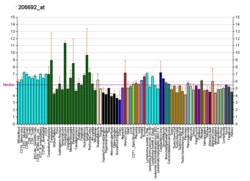KCNJ10
ATP-sensitive inward rectifier potassium channel 10 is a protein that in humans is encoded by the KCNJ10 gene.
This gene encodes a member of the inward rectifier-type potassium channel family, Kir4.1, characterized by having a greater tendency to allow potassium to flow into, rather than out of, a cell. Kir4.1, may form a heterodimer with another potassium channel protein and may be responsible for the potassium buffering action of glial cells in the brain. Mutations in this gene have been associated with seizure susceptibility of common idiopathic generalized epilepsy syndromes.
Humans with mutations in the KCNJ10 gene that cause loss of function in related K+ channels can display Epilepsy, Ataxia, Sensorineural deafness and Tubulopathy, the EAST syndrome (Gitelman syndrome phenotype) reflecting roles for KCNJ10 gene products in the brain, inner ear and kidney. The Kir4.1 channel is expressed in the Stria vascularis and is essential for formation of the endolymph, the fluid that surrounds the mechanosensitive stereocilia of the sensory hair cells that make hearing possible.
...
Wikipedia





